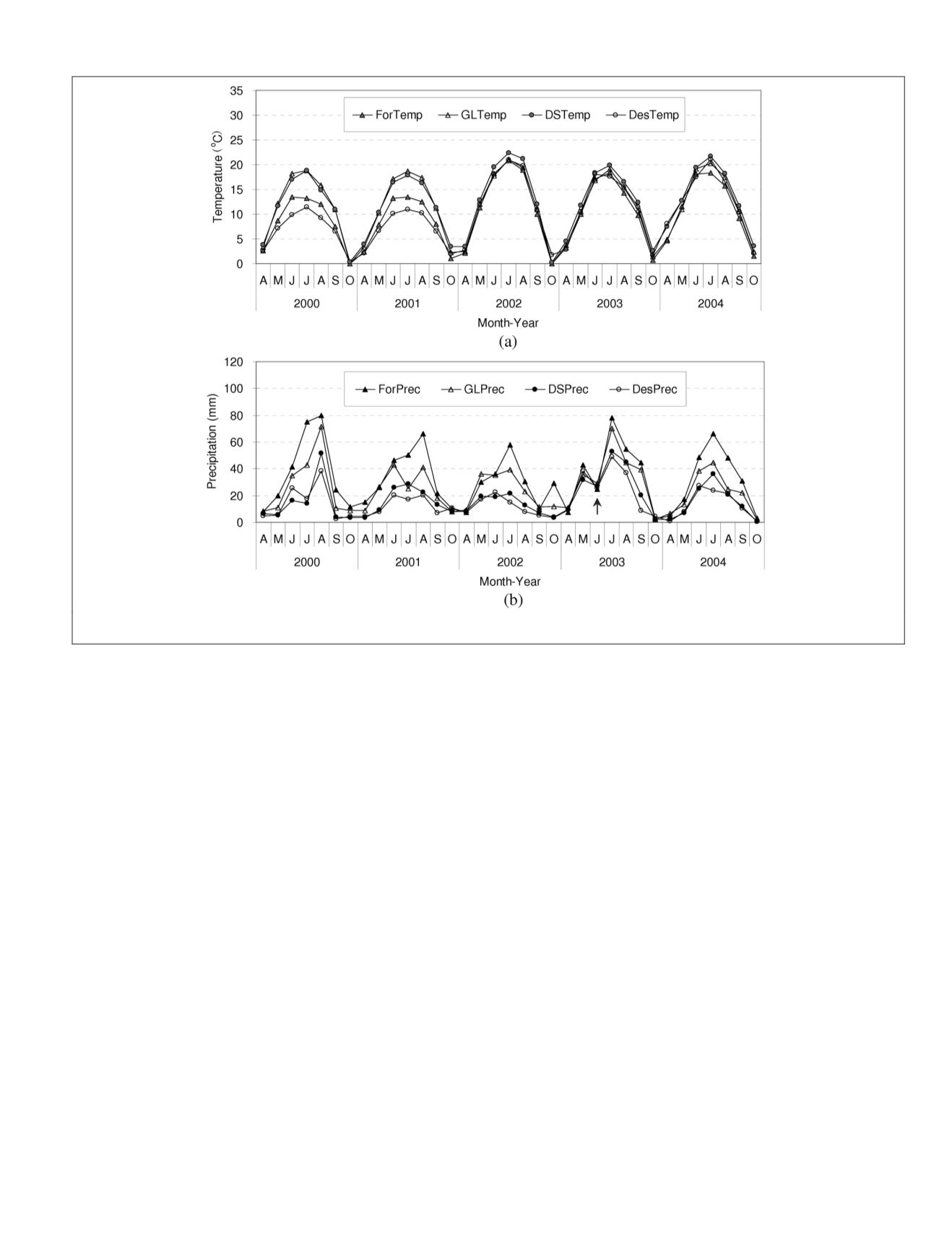
desert steppe, and desert can be explained by the monthly
average precipitations of 50, 65, 48, and 26 percent, respec-
tively; each of the values was smaller than the temperature-
based
mNPP
model for its corresponding terrestrial ecosystems.
The positive relationship between
NPP
and monthly
temperature and precipitation in Mongolia agrees with the
conclusions of Tang
et al
. (2010) and Wang
et al
. (2011)
that were derived from New England in northeast
USA
and
Guizhou in southwest China. The relationship consistency
among these regions also indicates that terrestrial ecosystems’
NPP
in growing season varies increasingly with temperature
and precipitation in typical continental climate, humid con-
tinental climate, and subtropical humid climate. It was also
found that the effect of precipitation is negligible (coefficient
is statistically identical to zero due to the P-value of
t
statistic
is very large, e.g., P >0.15) if both temperature and precipi-
tation were applied simultaneously as predictors for
NPP
estimation in each of the terrestrial ecosystems using multiple
regression analysis. It appeared that the precipitation is prob-
ably restrained by the temperature if both climatic factors are
input into a regression model. This condition does not appear
to have been addressed by other relevant articles. Since the
coefficients of these two regressors were tested with VIF <3 as
well as small values of conditional indices (ranging between 2
and 6), the models should be free of multicollinearity. In sum-
mary, precipitation and temperature are logically the driving
force of terrestrial ecosystems’
NPP
while the prediction of
NPP
can be more complicated to clarify which one or both of them
are imperative for better prediction in particular for regions
with continental climates and subtropical humid climates.
It is therefore suggested that further studies of the multiple
effects of climatic factors on
NPP
prediction should be con-
tinuously carried out as well as exploration of a generalized
model of climate factors on
NPP
in climate regions.
Change Pattern of the Increment Rate of mNPP
The percentage change of m
NPP
from between successive
months (d
NPP
= 100*(
mNPP
t2
−
mNPP
t1
)/
mNPP
t1
) was used to
determine the increment rate of
mNPP
for each of the vegeta-
tion types. A positive increment rate indicates vigorous plant
growth. The d
NPP
of forest, grassland, desert steppe, and
desert has shown that their temporal trends of growth rates in
years 2000 to 2004 were very similar (Figure 6). The biggest
positive slope of the trends was observed during the first pe-
riod April to May for all of the terrestrial ecosystems. This il-
lustrates that vigorous plant growth occurred and was almost
identical in each of the early growing seasons. Subsequently,
a smaller positive d
NPP
occurred in the second period May to
June indicating the vegetation was able to keep a similar level
of green biomass production in years 2000 to 2004. Another
general trend is that negative d
NPP
occurred simultaneously
in and after the period July to August among the terrestrial
ecosystems demonstrating that the vegetative vigor in Mongo-
lia started to decrease and reached low productivity after July.
Another noticeable phenomenon in June 2003 is that the
mPrec in each terrestrial ecosystem dropped off simultane-
ously. This suggests that the precipitation in June was abnor-
mal, particularly the degree of precipitation shortage in forest
and grassland was more significant than desert steppe and
desert. In comparison to the temporal trend of d
NPP
in Figure
6, all of the terrestrial ecosystems could retain d
NPP
at the
level of 20 percent in the second period May to June, a level
that was rarely achieved in the same period in the other years.
Figure 4. Temporal trends of (a) the monthly average temperature, and (b) precipitation of the vegetation types. The arrow indicates an
abnormal drop in June during the growing season in 2003.
PHOTOGRAMMETRIC ENGINEERING & REMOTE SENSING
July 2015
593


